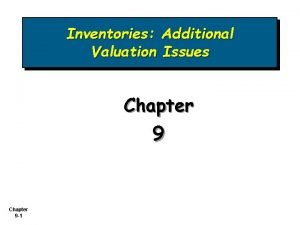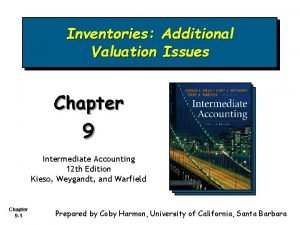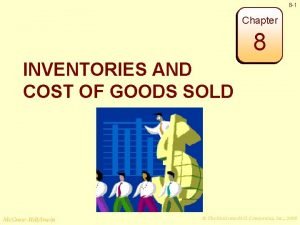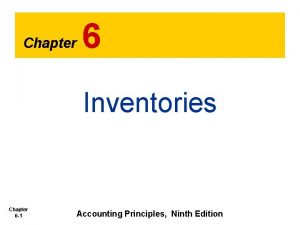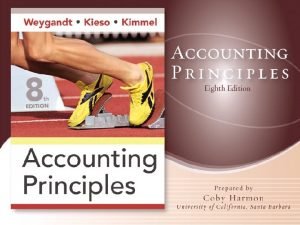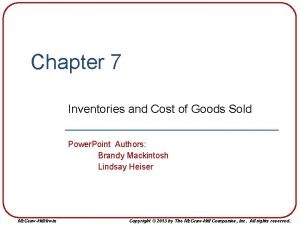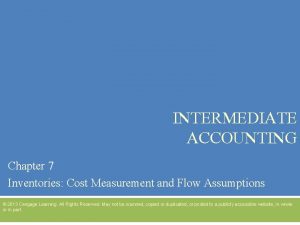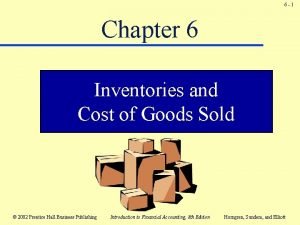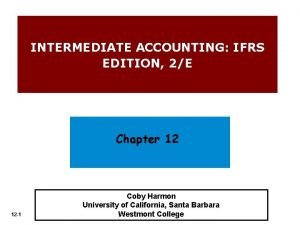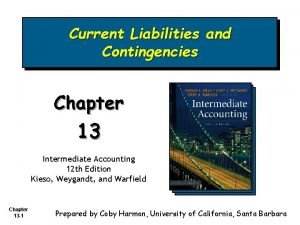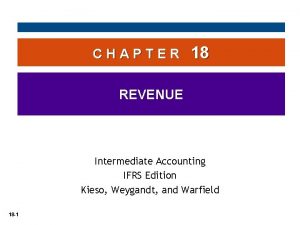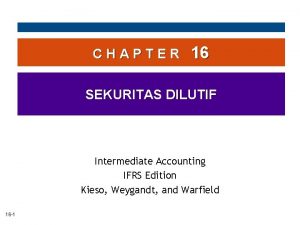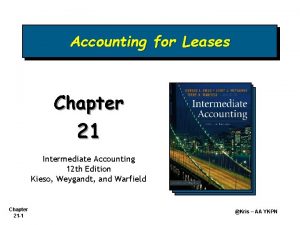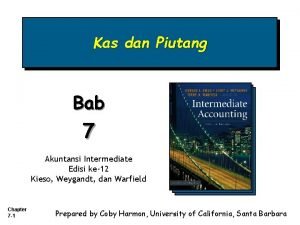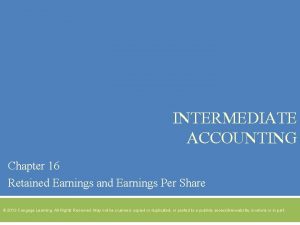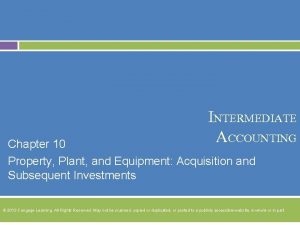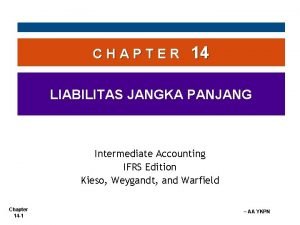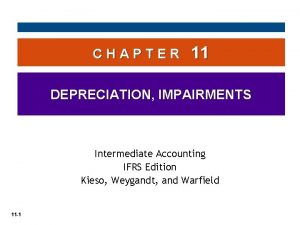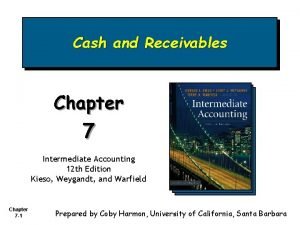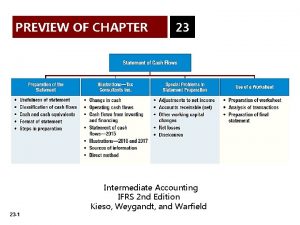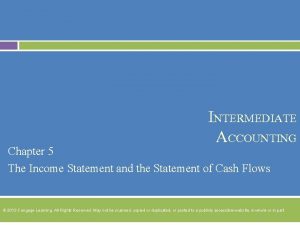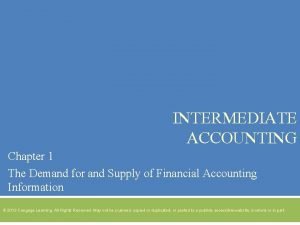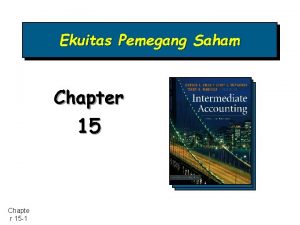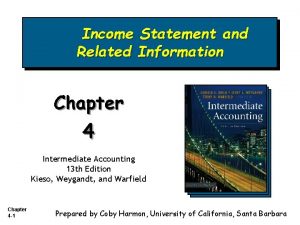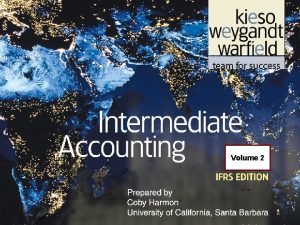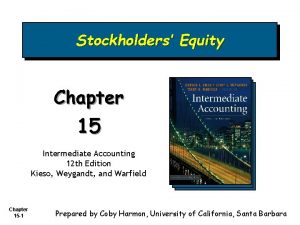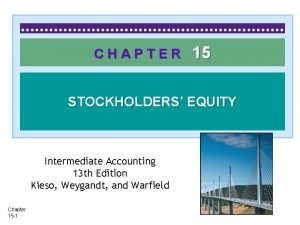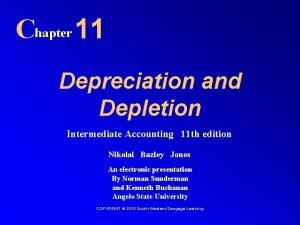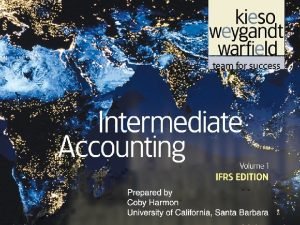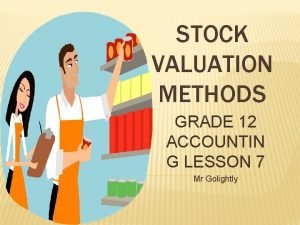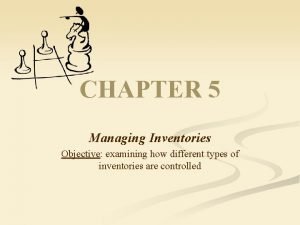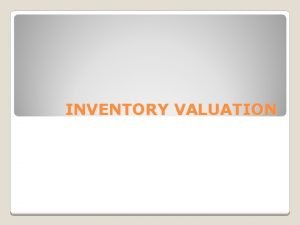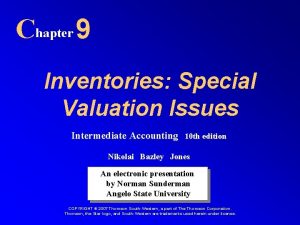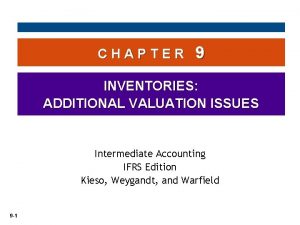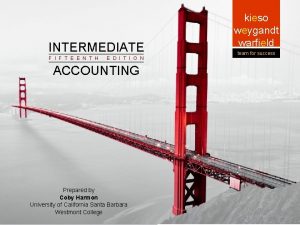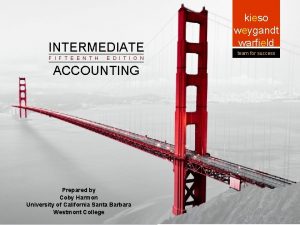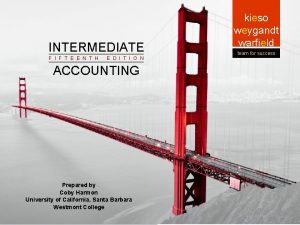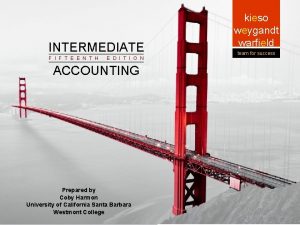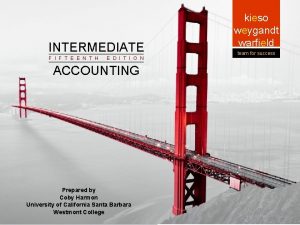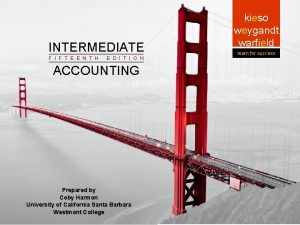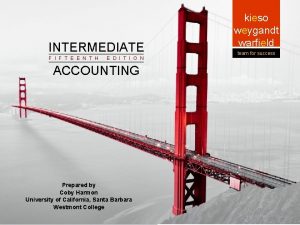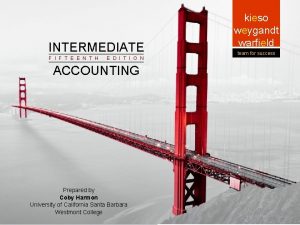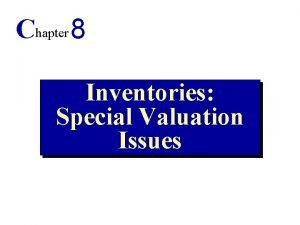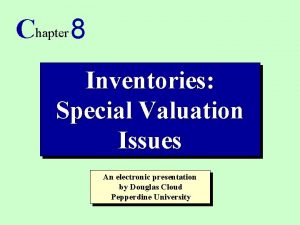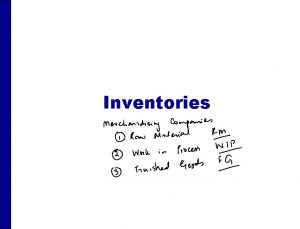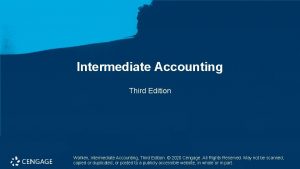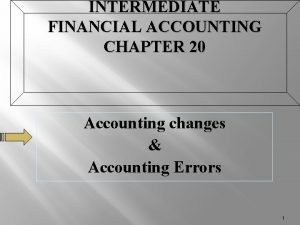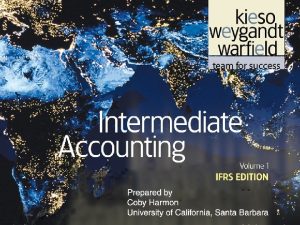Chapter 9 Inventories Special Valuation Issues Intermediate Accounting














































- Slides: 46

Chapter 9 Inventories: Special Valuation Issues Intermediate Accounting 11 th edition Nikolai Bazley Jones An electronic presentation By Norman Sunderman and Kenneth Buchanan Angelo State University COPYRIGHT © 2010 South-Western/Cengage Learning

2 Lower of Cost or Market The lower of cost or market rule requires that a company write down its inventory to its market value when the inventory’s utility has declined.

3 Lower of Cost or Market

4 Lower of Cost or Market The reduction of the value of the inventory to market and the recognition of a loss are appropriate for both a company’s balance sheet and income statement. GAAP defines assets as “probable future economic benefits. ” When the cost of the inventory exceeds the expected benefits, the lower market value is a better measure of the expected benefits. In other words, an unrecoverable cost is not an asset. A company should recognize the decline in value of the inventory as a reduction in the income of the period in which the loss occurs.

5 IFRS vs. U. S. GAAP v IFRS, like U. S. GAAP, require the use of the lower of cost or market method to value inventory. v However, market is defined as net realizable value and should typically be applied to individual items. v By defining market as net realizable value, IFRS eliminate the need to use a ceiling and a floor. v IFRS do not specify the income statement line item under which the write-down should be recorded. v While U. S. GAAP prohibits any reversal of a previous write-down, IFRS do allow the reversal of a previous write-down, which is then recognized in income.

6 Purchase Obligations To lock in prices and assure sufficient quantities of materials, companies often contract with suppliers to purchase a specified quantity of materials in the future at an agreed upon unit cost.

7 Product Financing In a product financing arrangement, the company “sells” the inventory to another company. Then, in a related transaction, it agrees to purchase the inventory (or a substantially identical item) back from the other company at specified prices over specified periods. Typically the inventory is not delivered to the “buyer” and is repurchased at a higher price, the difference being an interest charge. The company may not record sales revenue but instead must record the proceeds received as a liability.

8 Valuation Above Cost In exceptional cases, inventories properly may be stated above cost. v Precious metals having a fixed monetary value with no substantial cost of marketing v Agricultural, mineral, and other products, units of which are interchangeable and have an immediate marketability at quoted prices, and for which appropriate costs may be difficult to obtain

9 Estimating Inventory Two commonly used methods of estimating inventory costs are (1) the gross profit method and (2) the retail inventory method.

10 Gross Profit Method A company uses the gross profit method in the following situations: 1. To determine the cost of the inventory at the end of an interim period without taking a physical count. 2. For the internal or external auditor to check the reasonableness of an inventory cost developed from a physical inventory or perpetual inventory system. Continued

11 Gross Profit Method A company uses the gross profit method in the following situations: 3. To estimate the cost of inventory that is destroyed by a casualty. 4. To estimate the cost of inventory from incomplete records. 5. To develop a budget of cost of goods sold and ending inventory from a sales budget.

12 Gross Profit Method Step 1: The historical gross profit rate is calculated by dividing the gross profit of the prior period(s) by the net sales of the prior period(s). Assume 40%.

13 Gross Profit Method Step 2: The gross profit for the current period is estimated by multiplying the historical gross profit rate by the actual net sales for the period. Net sales Gross profit rate Estimated gross profit $130, 000 0. 40 $ 52, 000

14 Gross Profit Method Step 3: The estimated gross profit is subtracted from the actual net sales to determine the estimated cost of goods sold for the period. Net sales Estimated gross profit (from Slide 32) Estimated cost of goods sold $130, 000 (52, 000) $ 78, 000

15 Gross Profit Method Step 4: The estimated cost of goods sold is subtracted from the actual cost of goods available for sale to determine the estimated cost of the ending inventory. Beginning inventory $ 10, 000 Net purchases 90, 000 Cost of goods available for sale $100, 000 Less: Estimated cost of goods sold: Net sales $130, 000

16 Enhancing the Accuracy of the Gross Profit Method 1. A company should adjust the gross profit rate for known changes in the relationship between its gross profit and net sales. 2. A company may use a separate gross profit rate for each department or type of inventory that has a different markup percentage. 3. A company may use an average gross profit rate based on several past periods to average out period-to-period fluctuations.

17 Expressing Gross Profit Percentages Divide gross profit by sales to calculate profit as a percentage of sales. Gross Profit = Gross Profit as a Sales Percentage of Sales

18 Expressing Gross Profit Percentages If the gross margin percentage is expressed as a percentage of cost, it must be converted to a gross margin as a percentage of sales. Gross Profit as a % of Cost Gross Profit as a = Cost + Gross Profit as a % of Cost % of Sales

19 Retail Inventory Method Another method of estimating inventory is the retail inventory method, which is widely used because it is allowed under GAAP and for income tax purposes.

20 Retail Inventory Method Step 1: The total goods available for sale is computed at both cost and retail value. Cost Retail Beginning inventory Purchases $10, 000 50, 000 $ 17, 000 83, 000 Goods available for sale $60, 000 $100, 000

21 Retail Inventory Method Step 2: A cost-to-retail ratioisiscomputed. Cost Retail Beginning inventory Purchases $10, 000 50, 000 $ 17, 000 83, 000 Goods available for sale $60, 000 $100, 000 Cost-to-retail ratio: $ 60, 000 = 0. 60 $100, 000

22 Retail Inventory Method Step 2: Step 3: A The cost-to-retail ending inventory ratio is computed. at retail is computed. Cost Retail Beginning inventory Purchases $10, 000 50, 000 $ 17, 000 83, 000 Goods available for sale Less: Sales Ending inventory at retail $60, 000 $ 100, 000 (80, 000) $ 20, 000

23 Retail Inventory Method Step 4: The ending inventory at cost is computed. Cost Retail Beginning inventory Purchases $10, 000 50, 000 $ 17, 000 83, 000 Goods available for sale Less: Sales Ending inventory at retail Ending inventory at cost $60, 000 $ 100, 000 (80, 000) $ 20, 000 0. 60 × $20, 000 $12, 000

24 Retail Inventory Method Terminology Increased selling price to $12 Original selling price ($10) Additional Markup Cost ($6)

25 Retail Inventory Method Terminology Total Additional Markups – Total Markup Cancellations = Net Markup Reduced selling price to $10. 25 Cost ($6) Markup Cancellation

26 Retail Inventory Method Terminology Reduced selling price to $9 Cost ($6) Markup Cancellation Markdown

27 Retail Inventory Method Terminology Total Additional Markdowns – Total Markdown Cancellations = Net Markdown Increased selling price to $9. 60 Cost ($6) Markdown Cancellation

28 Retail Inventory Method For methods using cost, such as average cost, FIFO and LIFO, the net markdowns are included in calculating the cost-to-retail ratio.

29 Retail Inventory Method — FIFO The FIFO method excludes the beginning inventory in determining the cost-to-retail ratio. FIFO

30 Retail Inventory Method — Average Cost The average cost method includes the beginning inventory in determining the cost-to-retail ratio. Average Cost

31 Retail Inventory Method — LIFO Separate for the The LIFOcost-to-retail cost methodratios excludes beginning inventory in and the purchases beginning determining the must becost-to-retail calculated for the LIFO ratio. method. LIFO

32 Retail Inventory Method — Lower of Average Cost or Market The lower of cost or market method includes the beginning inventory, but excludes any net markdowns in determining the cost-to-retail ratio. Lower of Cost or Market

33 Conceptual Evaluation — Lower of Average Cost or Market The lower of cost or market method is accurate only if Under other either markups and conditions, the lower markdowns do not exist at of average cost or the time or if all the markedmarket produces an down items has been sold. inventory value that is less than cost but only approximates the lower of cost or market.

34 Dollar-Value LIFO Retail Method Information for following slides

35 Dollar-Value LIFO Retail Method Step 1: Calculate the ending inventory at retail. Beginning inventory Purchases Net markups Net markdowns Goods available for sale Sales Ending inventory at retail Cost $ 8, 000 20, 400 $28, 400 Retail $ 12, 000 3, 000 (1, 000) $ 46, 000 (29, 800) $ 16, 200

36 Dollar-Value LIFO Retail Method Step 2: Compute ending inventory to base-year retail prices by applying the base-year conversion index. Ending Current-Year Price Index Inventory at = Inventory × Base-Year Price Index at Retail Prices $15, 000 = $16, 200 × 100 108

37 Dollar-Value LIFO Retail Method Step 3: The increase (decrease) in the inventory at retail is computed by comparing the ending inventory with the beginning inventory. Ending inventory at base-year retail price…… Beginning inventory, 1/1/2010 Increase $15, 000 12, 000 $ 3, 000

38 Dollar-Value LIFO Retail Method Step 4: The increase (decrease) in the inventory at retail is converted to current-year retail prices. Layer Increase at Current-Year Price Index at Current-Year Base-Year = × Retail Prices Retail Base-Year Price Index Prices $3, 240 = $3, 000 × 100 108

39 Dollar-Value LIFO Retail Method Step 6: 5: The ending increaseinventory (decrease) atat cost current is -year retailby computed prices adding is converted (subtracting) to cost. increase (decrease) at cost to the $3, 240 × 0. 60 = $1, 944 the beginning inventory at cost. Cost of purchases was $20, 400 in 2010 while purchases adjusted for net markups and net markdowns was $34, 000 (32, 000 + $3, 000 – $1, 000) $20, 400 ÷ $34, 000 = 60% $1, 944 + $8, 000 = $9, 944 Beginning inventory at cost

40 Effects of Inventory Errors A purchase on credit is omitted from both the Purchases account and ending inventory and is not recorded in the succeeding year. Current Year Income Statement Income is correct. Balance Sheet Ending inventory and accounts payable are understated.

41 Effects of Inventory Errors A purchase on credit is omitted from both the Purchases account and ending inventory and is not recorded in the succeeding year. Succeeding Year Income Statement Income is overstated and cost of goods sold is understated. Balance Sheet Accounts payable is understated and retained earnings is overstated.

42 Effects of Inventory Errors A purchase on credit is omitted from the Purchases account but ending inventory is correct. Current Year Income Statement Income is overstated and cost of goods sold is understated. Balance Sheet Accounts payable is understated and retained earnings is overstated.

43 Effect of Inventory Errors A purchase on credit is omitted from the Purchases account but ending inventory is correct. Succeeding Year Income Statement No effect. Balance Sheet Accounts payable is understated and retained earnings is overstated.

44 Effect of Inventory Errors Ending inventory is over(under)stated due to quantity and/or costing errors, but the Purchases account is correct. Current Year Income Statement Income is over(under)stated and cost of goods sold is under(over)stated. Balance Sheet Ending inventory and retained earnings are over(under)stated.

45 Effect of Inventory Errors Ending inventory is over(under)stated due to quantity and/or costing errors, but the Purchases account is correct. Succeeding Year Income Statement Income is under(over)stated and cost of goods sold is over(under)stated. Balance Sheet No effect.

46 Chapter 9 Task Force Image Gallery clip art included in this electronic presentation is used with the permission of NVTech Inc.
 Chapter 9 inventories additional valuation issues
Chapter 9 inventories additional valuation issues Lower-of-cost-or-market
Lower-of-cost-or-market Valuation of fixed income securities or valuation of bonds
Valuation of fixed income securities or valuation of bonds Chapter 8 inventories and the cost of goods sold
Chapter 8 inventories and the cost of goods sold Principles of accounting chapter 6 answers
Principles of accounting chapter 6 answers Inventory costing methods
Inventory costing methods Chapter 7 inventories
Chapter 7 inventories Inventory intermediate accounting
Inventory intermediate accounting Chapter 6 inventories
Chapter 6 inventories Cost of retained earnings
Cost of retained earnings Intermediate accounting chapter 17 investments pdf
Intermediate accounting chapter 17 investments pdf Amortization expense formula
Amortization expense formula Chapter 13 current liabilities and contingencies
Chapter 13 current liabilities and contingencies Chapter 18 kieso
Chapter 18 kieso Intermediate accounting chapter 16
Intermediate accounting chapter 16 Kieso intermediate accounting chapter 21 solutions
Kieso intermediate accounting chapter 21 solutions Income tax expense
Income tax expense Bab 7 kas dan piutang kieso
Bab 7 kas dan piutang kieso A restriction/appropriation of retained earnings
A restriction/appropriation of retained earnings Chapter 10 property plant and equipment
Chapter 10 property plant and equipment Intermediate accounting chapter 2
Intermediate accounting chapter 2 Intermediate accounting chapter 14
Intermediate accounting chapter 14 Kunci jawaban buku intermediate accounting ifrs chapter 11
Kunci jawaban buku intermediate accounting ifrs chapter 11 Chapter 3 intermediate accounting
Chapter 3 intermediate accounting Intermediate accounting chapter 15
Intermediate accounting chapter 15 Financial accounting and accounting standards chapter 1
Financial accounting and accounting standards chapter 1 Chapter 13 intermediate accounting
Chapter 13 intermediate accounting First level of conceptual framework
First level of conceptual framework Cash and receivables chapter 7
Cash and receivables chapter 7 Retail inventory method
Retail inventory method Intermediate accounting chapter 23
Intermediate accounting chapter 23 Income statement intermediate accounting
Income statement intermediate accounting Intermediate accounting chapter 1
Intermediate accounting chapter 1 Contoh soal metode proporsional
Contoh soal metode proporsional Residual in accounting
Residual in accounting Income statement and related information chapter 4
Income statement and related information chapter 4 Intermediate accounting chapter 1
Intermediate accounting chapter 1 Intermediate accounting chapter 17 investments test bank
Intermediate accounting chapter 17 investments test bank Chapter 15 intermediate accounting
Chapter 15 intermediate accounting Large stock dividend journal entry
Large stock dividend journal entry Composite depreciation
Composite depreciation Impairment of intangible assets
Impairment of intangible assets Fifo method grade 12
Fifo method grade 12 Informal assessments for reading
Informal assessments for reading Non recycled inventory examples
Non recycled inventory examples Mnemjian inventories
Mnemjian inventories Juloidian inventories
Juloidian inventories
